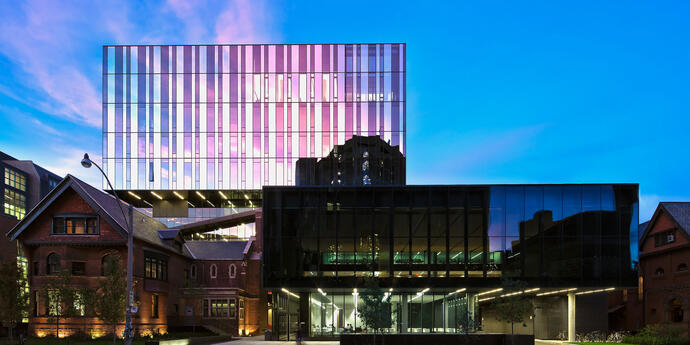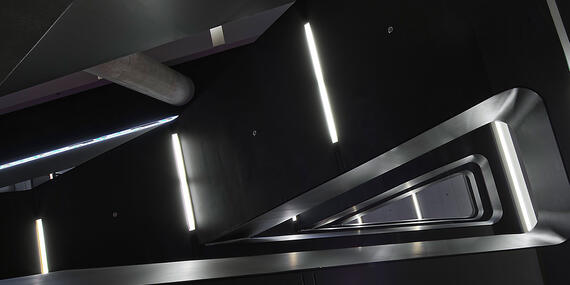
IES Illumination Awards, International Award of Merit (2013)
IES Illumination Awards, Toronto Section Award (2013)
Ontario Architects Association, Design Excellence Award (2013)
The business of great design.
This nine-storey addition to the south end of the existing business school connects to the latter via a four-storey atrium, with a feature stairway weaving through the space. Classrooms, student common areas, a full-service cafeteria and a 300-person event space occupy the bottom five floors of the building, while offices and meeting rooms make up the top floors.
Modelling what you want to see.
BIM was used for Smith + Andersen to internally test the mechanical design for clash detection and to verify installation in complicated areas such as mechanical rooms and congested ceiling spaces. The project utilizes steam and chilled water from the University’s central plant for heating and cooling. The tower portion incorporates a 100% outdoor air heat recovery unit to supply pre-treated outside air to compartment units on each floor, while the lower levels have dedicated air handlers (primarily variable air volume) capable of 100% outside air free cooling when ambient conditions permit. Energy-efficient features includes energy recovery wheels, demand control ventilation, and a complex building automation system to control and optimize the building’s mechanical system.
In order to achieve LEED certification, the project also includes low water consumption plumbing fixtures, a rainwater harvesting cistern for the irrigation system, and MERV-13 filters for improved indoor air quality. Unique mechanical design features include the integration of the existing five-storey business school and heritage building, a complex hybrid smoke control system for the original atrium, and implementation of various noise and vibration mitigation strategies.
The business of great design.
This nine-storey addition to the south end of the existing business school connects to the latter via a four-storey atrium, with a feature stairway weaving through the space. Classrooms, student common areas, a full-service cafeteria and a 300-person event space occupy the bottom five floors of the building, while offices and meeting rooms make up the top floors.
Modelling what you want to see.
BIM was used for Smith + Andersen to internally test the mechanical design for clash detection and to verify installation in complicated areas such as mechanical rooms and congested ceiling spaces. The project utilizes steam and chilled water from the University’s central plant for heating and cooling. The tower portion incorporates a 100% outdoor air heat recovery unit to supply pre-treated outside air to compartment units on each floor, while the lower levels have dedicated air handlers (primarily variable air volume) capable of 100% outside air free cooling when ambient conditions permit. Energy-efficient features includes energy recovery wheels, demand control ventilation, and a complex building automation system to control and optimize the building’s mechanical system.
In order to achieve LEED certification, the project also includes low water consumption plumbing fixtures, a rainwater harvesting cistern for the irrigation system, and MERV-13 filters for improved indoor air quality. Unique mechanical design features include the integration of the existing five-storey business school and heritage building, a complex hybrid smoke control system for the original atrium, and implementation of various noise and vibration mitigation strategies.

Maximizing flexibility.
The electrical systems are designed with maximum flexibility for current users and spare capacity for future growth. A new high voltage service accommodates the entire Rotman facility, with emergency power available from an existing generator in the original building’s parking level. Harmonic mitigating transformers have been provided for sensitive devices such as the audio-visual equipment added throughout the building. A complex smoke control system is tied into an upgraded, networked fire alarm system between the original building and the new addition.
True education is connected education.
The Rotman School of Business faculty program allows for dynamic and innovative ways of teaching and enriching the educational experience of the student. This project’s telecommunications infrastructure is designed to support such a demanding environment while providing flexibility to adapt to future technologies. The telecommunications infrastructure serves as the information highway for systems such as building automation, security cameras, wayfinding, and a highly-advanced audio-visual presentation and display system for classrooms and common areas.
The (high)lights.
Lighting fixtures align at the same location on every floor to enhance the architectural building lines. Linear luminaires are strategically placed in the main staircase to overcome and illuminate black finishes and hot pink features. High-efficiency luminaires with low-mercury T5 fluorescent lamps minimize the lighting power density. Motion sensors, daylight sensors and low voltage controls optimize the lighting performance while providing energy savings.















